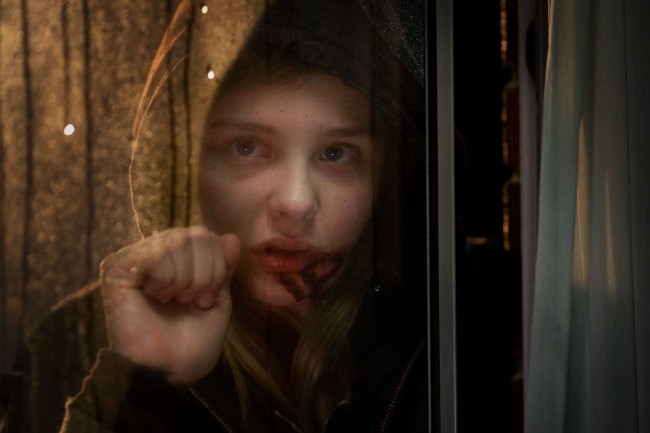Let Me In
This Remake Has Teeth…Sort Of

Starring: Chloe Moretz, Kodi Smit-McPhee
By Robert Patrick
“Let The Right One In”, a Swedish vampire movie where mood and suspense coexist in a shadowy tandem, should be, by all accounts, immune to remake territory. Unfortunately, because Americans think reading subtitles are as deadly as staring into the eyes of Medusa, Hollywood thought this re-imagination was a necessary evil. And while I’m glad they didn’t butcher the original with their bloody maws, I still cant, no matter how hard I think about it, find a reason to suggest seeing this remix over the original record. Also, why go with the title “Let Me In”? To me, this moniker sounds like a romantic comedy, urging someone to let them into their heart. Gross.
Set in nineteen-eighties America, where president Reagan is made up of pulsating pixels on fuzzy snow-globe televisions, and the sky of New Mexico is forever hushed by vapid strokes of dry grays, lives a despondent twelve-year old girl named Abby. In the same apartment complex lives Owen, a young boy, about the same age as the aforementioned girl, who also wallows in adolescent confusion. The two of them engage in a most unusual friendship, where, due to Abby’s affliction, their lives becomes impossibly complicated.
The atmosphere in “Let Me In” is repeatedly speckled with charcoal blacks and cobblestone whites. There is nothing even remotely close to looking placid or innocuous about this clammy marriage of destitute buildings and a sky that is siphoned of color. The mood is definitely palpable, thank goodness, because this story relies on atmosphere as its very macabre pulse. When the film skulks about in these morose shadows, the story works, because there is a sense of uncertainty and, during times of sentience, a sweet sort of darkness.
The original film is an ode to the intangible nature of childhood naiveté; the power of emotion that children possess, but are unable to harness, due to their lack of cognitive prowess. In its rawest and most organic form, love and hatred are clumsy and jagged-rock beds. As an adult, one can, but not always, become well-versed in acknowledging these passions. A child, however, knows not how to positively identify these feelings let alone rebuke them. This is where “Let the Right One In” succeeded. There is a subtle fear that builds, like a ball of coagulated anxiety, until you’re left spun with introspection.
Director Matt Reeves’ take on the Swedish film is an amiable one, and he largely succeeds due to the film’s muted palette and subdued dialogue. A lot of this film is poetically beautiful. Whenever Reeves switches on the violence, however, it’s almost akin to someone walking into a museum with a foghorn – it’s perfectly distracting and wholly unnecessary. The CGI is completely piteous when used. The dancing baby, from the early years of computer animation, looks light years better than this pulpy-batch of special effects. It’s a shame, considering that the story really doesn’t require this sort of gratuitous behavior in the first place. You wouldn’t shoehorn thirty-gallons of blood into “Rosemary’s Baby” just because you had the money to. Then again, American audiences feed off of shock and throw away suspense like excess fat on a steak.
The two leads in the film, Chloe Moretz and Kodi Smit-McPhee, do a fantastic job of playing off of each other. The integrity of the film rests on their scrawny adolescent shoulders, and they still, despite the dense muck that weighs the film down, are able to briskly move out from under it. Moretz’s coy vocal tics lacquer the film, in a weird decoupage of intimidation and sweetness, that works to an outstanding degree. You understand the volatile hostility that lurks beneath this diminutive vessel of flesh. Meanwhile, Smit-McPhee embodies the damp fuse of adolescent confusion. The two young actors are great together. The supporting cast, including that of the fantastic Richard Jenkins, also patch up a perforated remake.
And while the first film is better as a whole, this picture is great because of the way it filters out the saccharine of the nineteen-eighties and injects the era instead with defused colors that would make the lead of a pencil seem neon in comparison. If there ends up being a director’s cut, without the atrocious CGI, I would be enamored with this film slightly more than I am today. As it stands, there is no reason, other than being completely lazy, to not see the original Swedish film.
3.5/5
